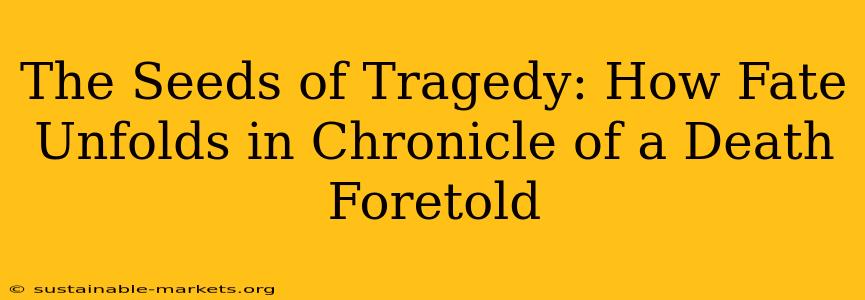Gabriel García Márquez's Chronicle of a Death Foretold isn't just a story; it's a chilling exploration of fate, honor, and the suffocating weight of societal expectations. The novel masterfully weaves a tapestry of foreshadowing, revealing the inevitable death of Santiago Nasar even as the characters unknowingly march toward it. This essay will delve into the intricate web of circumstances that lead to Santiago's demise, examining how seemingly small actions and ingrained cultural norms combine to create a tragedy that feels both inescapable and profoundly avoidable.
What is the central conflict in Chronicle of a Death Foretold?
The central conflict isn't a simple clash between individuals but a complex interplay between individual agency and the overwhelming power of societal forces. Santiago Nasar is the victim, but the true antagonist is a system that breeds fatalistic acceptance of violence as a means of upholding honor. The conflict lies in the inability of the town, and even Santiago himself, to disrupt the preordained course of events, despite numerous opportunities to do so. This conflict is rooted in the rigid social structures of the town and the unshakeable belief in a predetermined fate.
What is the role of fate in Chronicle of a Death Foretold?
Fate, or perhaps more accurately, the self-fulfilling prophecy, is a dominant force in the narrative. The repeated warnings, the inaction of the townspeople, and even Santiago's own obliviousness all contribute to a sense of inevitability. Márquez masterfully uses foreshadowing throughout the novel; the numerous hints and warnings become almost unbearable as the reader knows what's coming, creating a sense of tragic helplessness. This isn't a passive fate, though; it’s a fate shaped by the actions, or inactions, of the characters.
How does the setting of the novel contribute to the tragedy?
The isolated, almost claustrophobic setting of the small coastal town plays a crucial role in shaping the tragedy. The close-knit community, bound by tradition and gossip, creates an environment where secrets are shared, rumors spread like wildfire, and a sense of collective responsibility is utterly absent. The town's social fabric, with its rigid hierarchies and obsession with honor, actively contributes to the tragedy by stifling dissent and discouraging intervention. The setting isn't merely a backdrop; it's an active participant in the unfolding drama.
What are the major themes in Chronicle of a Death Foretold?
Chronicle of a Death Foretold explores several interconnected themes:
- Fate vs. Free Will: The novel constantly questions the extent to which individuals can control their destinies within a society governed by tradition and machismo.
- Honor and Violence: The concept of honor, often twisted and misinterpreted, fuels the violence at the heart of the narrative. The Vicario brothers' actions, though brutal, are presented as a twisted attempt to restore family honor.
- Social Responsibility and Inaction: The novel critiques the collective inaction of the townspeople, who, despite knowing about the impending murder, fail to intervene. This highlights the devastating consequences of apathy and collective responsibility.
- Memory and Storytelling: The fragmented narrative, pieced together through retrospective accounts, emphasizes the subjectivity of memory and the difficulties of reconstructing the past accurately. The constant retellings serve to highlight the enduring impact of the event and its complexities.
How does the novel's structure contribute to its impact?
The novel's non-linear structure, moving back and forth in time, mirrors the fragmented and unreliable nature of memory. This structure enhances the sense of inevitability, as the reader is privy to the unfolding events even as the characters remain oblivious. By presenting the story from multiple perspectives, the novel avoids a simplistic attribution of blame and compels the reader to grapple with the complexities of the tragedy.
In conclusion, Chronicle of a Death Foretold is a powerful exploration of fate and free will, honor and violence, and the devastating consequences of societal pressures and collective inaction. Márquez masterfully uses foreshadowing, setting, and narrative structure to create a chilling and unforgettable tale that continues to resonate with readers long after they finish the final page. The seeds of tragedy are sown not just in individual actions, but in the deeply ingrained cultural norms and the failure of a community to intervene. The novel serves as a stark reminder of the devastating power of societal expectations and the crucial importance of challenging established norms to prevent similar tragedies from occurring.

